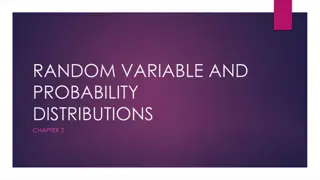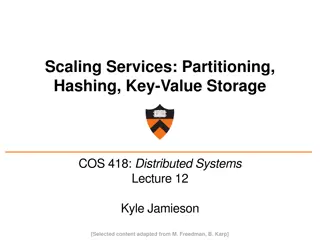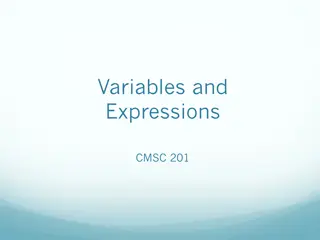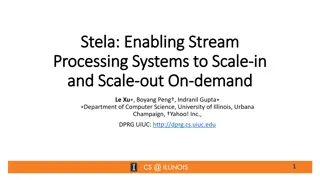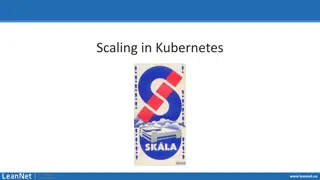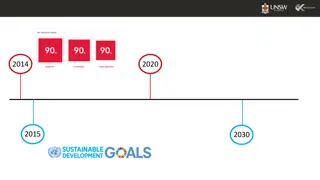
Understand Data Transformation: Scaling, Shifting, Combining
Learn how adding or multiplying constants to datasets affects statistical measures like mean, median, and spread. Explore the impact on test scores when transforming variables through scaling and shifting operations. Discover the importance of these techniques in data analysis and interpretation.
Download Presentation

Please find below an Image/Link to download the presentation.
The content on the website is provided AS IS for your information and personal use only. It may not be sold, licensed, or shared on other websites without obtaining consent from the author. If you encounter any issues during the download, it is possible that the publisher has removed the file from their server.
You are allowed to download the files provided on this website for personal or commercial use, subject to the condition that they are used lawfully. All files are the property of their respective owners.
The content on the website is provided AS IS for your information and personal use only. It may not be sold, licensed, or shared on other websites without obtaining consent from the author.
E N D
Presentation Transcript
Scaling, Shifting, Combining Variables Chapters 5 and 6
Lets have a look at our test scores (the top 3 and bottom 3 have been deleted) Here are the summary statistics: Statistic Mean 86 Median 87 Q1 81 Q3 92 Std Dev 9.1 IQR (Q3 Q1)11 Range (max-min)40 Value measures of center or position measures of spread
Lets pretend that I add 50 points to EVERYONEs score. (don t worry, I won t. that s just ridiculous) What would happen to these statistics? after +50? 136 137 131 142 9.1 11 40 Statistic Value Mean 86 Median 87 Q1 81 Q3 92 Std Dev 9.1 IQR 11 Range 40
Shifting data (adding) Adding (or subtracting) a constant to every data value adds (or subtracts)that constant to measures of position/center but does NOT change measures of spread. after +50? 136 137 131 142 9.1 11 40 Statistic Value Mean 86 Median 87 Q1 81 Q3 92 Std Dev 9.1 IQR 11 Range 40
Lets say that I multiply EVERYONEs score by 2. (perish the thought.) Now what would happen? after x2? 172 174 162 184 18.2 22 80 Statistic Value Mean 86 Median 87 Q1 81 Q3 92 Std Dev 9.1 IQR 11 Range 40
Scaling data (multiplying) Multiplyingevery data value by a constant causes measures of position/center and measures of spread to be multiplied by that constant. after x2? 172 174 162 184 18.2 22 80 Statistic Value Mean 86 Median 87 Q1 81 Q3 92 Std Dev 9.1 IQR 11 Range 40
combining scaling and shifting! wheeeee!!!
We have the following test scores: 46 49 52 54 56 59 64 68 min = 46 mean = 56 Q1 = 50.5 range = 22 median = 55 IQR = 11 Q3 = 61.5 std dev = 7.426 max = 68
Suppose the teacher first multiplies all test scores by 2, thensubtracts 30 from each 46 49 52 54 56 92 98 104 108 112 118 128 136 59 64 68 x2 -30 62 68 74 78 82 88 98 106 x2 then -30 min = 46 then -30 mean = 56 x2 x2 Q1 = 50.5 then -30 range = 22 x2 x2 median = 55 then -30 IQR = 11 x2 x2 Q3 = 61.5 then -30 std dev = 7.426 x2 max = 68 then -30 x2
Practice with scaling and shifting 1 2 4 7 7 9 12 Multiply each value by 5 and add 4. Find these new measures of center and spread. Measures of center and spread: Mean Median Range IQR St Dev 6 7 11 7 3.9 34 39 55 35 19.5
BACK TO THE BACONATOR TRIPLE (THIS ONE S NOT ON YOUR PRINTOUT ) 81 810 23 29 33 39 40 45 52 58 63 65 ____ IF THE 81 WERE MISTYPED AS 5 number summary: Would it affect the Min: 23 a) Mean? (YES) Q1: 36 b) Median? (NO) Q2: 45 c) IQR? (NO since Q3 and Q1 would not change) d) SD? (YES, since the mean would change) Q3: 60.5 e) Range? (YES, since the maximum has changed) Max: 81
When adding or subtracting two independent variables, x and y : += + = X Y X Y X Y X Y = + 2 X 2 Y Only possible if x and y are INDEPENDENT X Y ALWAYS ADD VARIANCES!
Natalie and Michelle are roommates that both work as waitresses in two different restaurants. The amount of money that Michelle earns in a week is a random variable with a mean of $500 and a standard deviation of $75. The amount of money that Natalie earns in a week is a random variable with a mean of $600 and a standard deviation of $100. The two of them work in different parts of Austin, so we will assume that the two ladies earnings are independent of one another. We will also assume that the distributions for each ladies weekly earnings are approximately normally distributed.
M = 500 M = 75 N = 600 N = 100 a) What are the mean and standard deviation for Michelle and Natalie s combined earnings (M + N) for one week? M+N = $1100 M+N = $125 b) What are the mean and standard deviation for the difference in (N M), Natalie s earnings and Michelle s earnings for one week? N-M = $100 N-M = $125
STOP!!! (be sure to check for updated HW)








